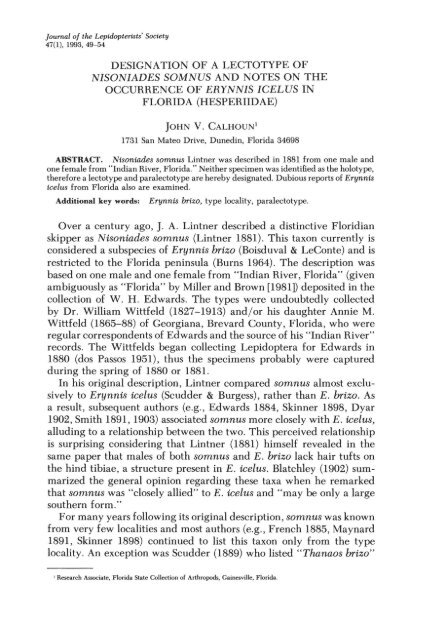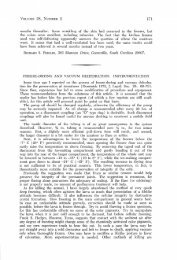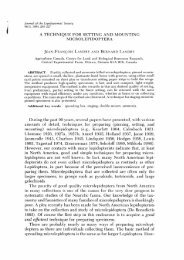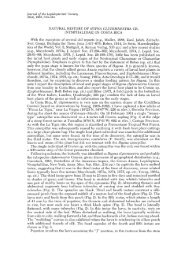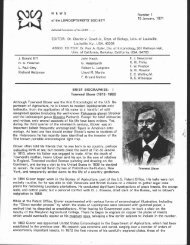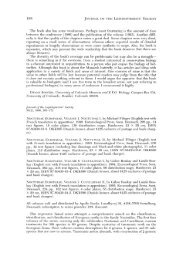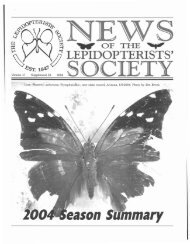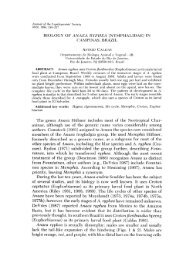nisoniades somnus and notes on the occurrence of erynnis icelus in
nisoniades somnus and notes on the occurrence of erynnis icelus in
nisoniades somnus and notes on the occurrence of erynnis icelus in
You also want an ePaper? Increase the reach of your titles
YUMPU automatically turns print PDFs into web optimized ePapers that Google loves.
Journal <strong>of</strong> <strong>the</strong> Lepidopterists' Society47(1), 1993, 49-54DESIGNA TION OF A LECTOTYPE OFNISONIADES SOMNUS AND NOTES ON THEOCCURRENCE OF ERYNNIS ICELUS INFLORIDA (HESPERIIDAE)JOHN V. CALHOUN]1731 San Mateo Drive, Duned<strong>in</strong>, Florida 34698ABSTRACT. Nis<strong>on</strong>iades <str<strong>on</strong>g>somnus</str<strong>on</strong>g> L<strong>in</strong>tner was described <strong>in</strong> 1881 from <strong>on</strong>e male <str<strong>on</strong>g>and</str<strong>on</strong>g><strong>on</strong>e female from "Indian River, Florida." Nei<strong>the</strong>r specimen was identified as <strong>the</strong> holotype,<strong>the</strong>refore a lectotype <str<strong>on</strong>g>and</str<strong>on</strong>g> paralectotype are hereby designated. Dubious reports <strong>of</strong> Erynnis<strong>icelus</strong> from Florida also are exam<strong>in</strong>ed.Additi<strong>on</strong>al key words:Erynnis hrizo, type locality, paralectotype.Over a century ago, J. A. L<strong>in</strong>tner described a dist<strong>in</strong>ctive Floridianskipper as Nis<strong>on</strong>iades <str<strong>on</strong>g>somnus</str<strong>on</strong>g> (L<strong>in</strong>tner 1881). This tax<strong>on</strong> currently isc<strong>on</strong>sidered a subspecies <strong>of</strong> Erynnis brizo (Boisduval & LeC<strong>on</strong>te) <str<strong>on</strong>g>and</str<strong>on</strong>g> isrestricted to <strong>the</strong> Florida pen<strong>in</strong>sula (Burns 1964). The descripti<strong>on</strong> wasbased <strong>on</strong> <strong>on</strong>e male <str<strong>on</strong>g>and</str<strong>on</strong>g> <strong>on</strong>e female from "Indian River, Florida" (givenambiguously as "Florida" by Miller <str<strong>on</strong>g>and</str<strong>on</strong>g> Brown [1981]) deposited <strong>in</strong> <strong>the</strong>collecti<strong>on</strong> <strong>of</strong> W. H. Edwards. The types were undoubtedly collectedby Dr. William Wittfeld (1827-1913) <str<strong>on</strong>g>and</str<strong>on</strong>g>/or his daughter Annie M.Wittfeld (1865-88) <strong>of</strong> Georgiana, Brevard County, Florida, who wereregular corresp<strong>on</strong>dents <strong>of</strong> Edwards <str<strong>on</strong>g>and</str<strong>on</strong>g> <strong>the</strong> source <strong>of</strong> his "Indian River"records. The Wittfelds began collect<strong>in</strong>g Lepidoptera for Edwards <strong>in</strong>1880 (dos Passos 1951), thus <strong>the</strong> specimens probably were captureddur<strong>in</strong>g <strong>the</strong> spr<strong>in</strong>g <strong>of</strong> 1880 or 1881.In his orig<strong>in</strong>al descripti<strong>on</strong>, L<strong>in</strong>tner compared <str<strong>on</strong>g>somnus</str<strong>on</strong>g> almost exclusivelyto Erynnis <strong>icelus</strong> (Scudder & Burgess), ra<strong>the</strong>r than E. brizo. Asa result, subsequent authors (e.g., Edwards 1884, Sk<strong>in</strong>ner 1898, Dyar1902, Smith 1891, 1903) associated <str<strong>on</strong>g>somnus</str<strong>on</strong>g> more closely with E. <strong>icelus</strong>,allud<strong>in</strong>g to a relati<strong>on</strong>ship between <strong>the</strong> two. This perceived relati<strong>on</strong>shipis surpris<strong>in</strong>g c<strong>on</strong>sider<strong>in</strong>g that L<strong>in</strong>tner (1881) himself revealed <strong>in</strong> <strong>the</strong>same paper that males <strong>of</strong> both <str<strong>on</strong>g>somnus</str<strong>on</strong>g> <str<strong>on</strong>g>and</str<strong>on</strong>g> E. brizo lack hair tufts <strong>on</strong><strong>the</strong> h<strong>in</strong>d tibiae, a structure present <strong>in</strong> E. <strong>icelus</strong>. Blatchley (1902) summarized<strong>the</strong> general op<strong>in</strong>i<strong>on</strong> regard<strong>in</strong>g <strong>the</strong>se taxa when he remarkedthat <str<strong>on</strong>g>somnus</str<strong>on</strong>g> was "closely allied" to E. <strong>icelus</strong> <str<strong>on</strong>g>and</str<strong>on</strong>g> "may be <strong>on</strong>ly a largesou<strong>the</strong>rn form."For many years follow<strong>in</strong>g its orig<strong>in</strong>al descripti<strong>on</strong>, <str<strong>on</strong>g>somnus</str<strong>on</strong>g> was knownfrom very few localities <str<strong>on</strong>g>and</str<strong>on</strong>g> most authors (e.g., French 1885, Maynard1891, Sk<strong>in</strong>ner 1898) c<strong>on</strong>t<strong>in</strong>ued to list this tax<strong>on</strong> <strong>on</strong>ly from <strong>the</strong> typelocality. An excepti<strong>on</strong> was Scudder (1889) who listed "Thanaos brizo"J Research Associate, Florida State Collecti<strong>on</strong> <strong>of</strong> Arthropods, Ga<strong>in</strong>esviJIe, Florida.
50 JOURNAL OF THE LEPIDOPTERISTS' SOCIETYfrom Florida <str<strong>on</strong>g>and</str<strong>on</strong>g> <strong>in</strong>cluded <strong>the</strong> additi<strong>on</strong>al locality <strong>of</strong> "Haulover." Thisrecord was provided by E. A. Schwarz, probably as a result <strong>of</strong> his visitsto Florida <strong>in</strong> 1875 <str<strong>on</strong>g>and</str<strong>on</strong>g> 1876 (Schwarz 1888). This reference is especially<strong>in</strong>terest<strong>in</strong>g because Haulover formerly existed <strong>in</strong> nor<strong>the</strong>rn BrevardCounty, approximately 22 km north <strong>of</strong> Georgiana, where <strong>the</strong> typespecimens <strong>of</strong> N. <str<strong>on</strong>g>somnus</str<strong>on</strong>g> probably orig<strong>in</strong>ated. Schwarz obviously recognized<strong>the</strong> similarity <strong>of</strong> his specimens to E. hrizo <str<strong>on</strong>g>and</str<strong>on</strong>g> identified <strong>the</strong>mas such. This was <strong>the</strong> first glimpse <strong>in</strong>to <strong>the</strong> true relati<strong>on</strong>ship between<strong>the</strong>se taxa.Dyar (1905) was <strong>the</strong> first to openly suggest that <str<strong>on</strong>g>somnus</str<strong>on</strong>g> was "perhapsbut a dark form <strong>of</strong> hrizo" <str<strong>on</strong>g>and</str<strong>on</strong>g> noted <strong>the</strong> resemblance <strong>of</strong> <strong>the</strong>ir genitalia.This noti<strong>on</strong> was supported by Sk<strong>in</strong>ner (1914) who also commented <strong>on</strong><strong>the</strong> similarity <strong>of</strong> <strong>the</strong>ir genitalia. F. E. Wats<strong>on</strong> (<strong>in</strong> Grossbeck 1917) morec<strong>on</strong>fidently submitted that <str<strong>on</strong>g>somnus</str<strong>on</strong>g> is "probably a subspecies <strong>of</strong> hrizo."Follow<strong>in</strong>g <strong>the</strong> acceptance <strong>of</strong> <str<strong>on</strong>g>somnus</str<strong>on</strong>g> asa subspecies <strong>of</strong> E. hrizo byBarnes <str<strong>on</strong>g>and</str<strong>on</strong>g> McDunnough (1917), this tax<strong>on</strong>omic status was generallyadopted. However, Holl<str<strong>on</strong>g>and</str<strong>on</strong>g> (1931) stated that he was "unable to agreewith this op<strong>in</strong>i<strong>on</strong>" <str<strong>on</strong>g>and</str<strong>on</strong>g> reta<strong>in</strong>ed <strong>the</strong> mistaken belief that <str<strong>on</strong>g>somnus</str<strong>on</strong>g> was"much nearer to T. <strong>icelus</strong>."L<strong>in</strong>tner (1881) did not designate ei<strong>the</strong>r <strong>of</strong> his specimens <strong>of</strong> Nis<strong>on</strong>iades<str<strong>on</strong>g>somnus</str<strong>on</strong>g> as <strong>the</strong> holotype. Miller <str<strong>on</strong>g>and</str<strong>on</strong>g> Brown (1981) were unaware <strong>of</strong> <strong>the</strong>locati<strong>on</strong> <strong>of</strong> L<strong>in</strong>tner's syntypes although Sk<strong>in</strong>ner (1914) stated that <strong>the</strong>ywere deposited <strong>in</strong> <strong>the</strong> Carnegie Museum <strong>of</strong> Natural History, where<strong>the</strong>y rema<strong>in</strong> today. These specimens were figured by Holl<str<strong>on</strong>g>and</str<strong>on</strong>g> (1931:plate 51, figs. 3-4) who identified each as "type." Both specimens lackantennae (<strong>the</strong> male reta<strong>in</strong>s a porti<strong>on</strong> <strong>of</strong> <strong>the</strong> left antenna) which werenoticeably drawn <strong>on</strong>to <strong>the</strong> Holl<str<strong>on</strong>g>and</str<strong>on</strong>g> figures. The specimens are <strong>in</strong> goodc<strong>on</strong>diti<strong>on</strong>, except <strong>the</strong> abdomen <strong>of</strong> <strong>the</strong> female is now detached <str<strong>on</strong>g>and</str<strong>on</strong>g>p<strong>in</strong>ned with <strong>the</strong> specimen <strong>in</strong> a dry vial. The male specimen (Fig. 1)(left forew<strong>in</strong>g length, base to apex = 15 mm) is hereby designated as<strong>the</strong> lectotype. It bears three labels: "Nis<strong>on</strong>iades/Somnus, c3/L<strong>in</strong>tn./TYPE." <strong>in</strong> L<strong>in</strong>tner's h<str<strong>on</strong>g>and</str<strong>on</strong>g>; "Collecti<strong>on</strong>/W. H. Edwards" pr<strong>in</strong>ted; <str<strong>on</strong>g>and</str<strong>on</strong>g>"Butterfly Book/PI. 51 Fig. 3," pr<strong>in</strong>ted <str<strong>on</strong>g>and</str<strong>on</strong>g> h<str<strong>on</strong>g>and</str<strong>on</strong>g>written. I have affixeda red label declar<strong>in</strong>g <strong>the</strong> specimen as <strong>the</strong> lectotype. The female specimen(Fig. 2) (left forew<strong>in</strong>g length, base to apex = 16 mm) is designatedas a paralectotype. It also bears three labels: "Nis<strong>on</strong>iades/ Somnus,'i?/L<strong>in</strong>tn./ TYPE." <strong>in</strong> L<strong>in</strong>tner's h<str<strong>on</strong>g>and</str<strong>on</strong>g>; "Collecti<strong>on</strong>/W. H. Edwards"pr<strong>in</strong>ted; <str<strong>on</strong>g>and</str<strong>on</strong>g> "Butterfly Book/PI. 51 Fig. 4," pr<strong>in</strong>ted <str<strong>on</strong>g>and</str<strong>on</strong>g> h<str<strong>on</strong>g>and</str<strong>on</strong>g>written.A red label has been affixed to <strong>in</strong>dicate its status as paralectotype. Thetype locality is restricted to Georgiana, approximately 5 km south <strong>of</strong><strong>the</strong> city <strong>of</strong> Merritt Isl<str<strong>on</strong>g>and</str<strong>on</strong>g>, Brevard County, Florida. An additi<strong>on</strong>al malespecimen <strong>of</strong> E. h. <str<strong>on</strong>g>somnus</str<strong>on</strong>g> was figured by Holl<str<strong>on</strong>g>and</str<strong>on</strong>g> (1898, 1931:plate48, fig. 2). This specimen, from <strong>the</strong> W. H. Edwards collecti<strong>on</strong>, is labelled
VOLUME 47, NUMBER 1 51FIGS. 1-2.Nis<strong>on</strong>iades <str<strong>on</strong>g>somnus</str<strong>on</strong>g> L<strong>in</strong>tner. 1, Lectotype male; 2, Paralectotype female.<strong>in</strong> Edwards' h<str<strong>on</strong>g>and</str<strong>on</strong>g> as "<str<strong>on</strong>g>somnus</str<strong>on</strong>g>/ ~/Ind. Riv." <str<strong>on</strong>g>and</str<strong>on</strong>g> is c<strong>on</strong>sidered a topotype.Unlike most <strong>of</strong> Edwards' specimens, <strong>the</strong> types <strong>of</strong> N. <str<strong>on</strong>g>somnus</str<strong>on</strong>g> do notpossess locality data. Edwards did not place labels <strong>on</strong> his <strong>in</strong>dividualspecimens until he sold his collecti<strong>on</strong> to W. J. Holl<str<strong>on</strong>g>and</str<strong>on</strong>g> <strong>in</strong> <strong>the</strong> late 1880's(Brown 1964). At that time, he prepared labels that typically <strong>in</strong>cluded<strong>the</strong> name <strong>of</strong> <strong>the</strong> species, sex <strong>of</strong> <strong>the</strong> specimen <str<strong>on</strong>g>and</str<strong>on</strong>g> a brief (sometimescryptic) menti<strong>on</strong> <strong>of</strong> <strong>the</strong> locati<strong>on</strong> <strong>of</strong> capture. Edwards probably did notaffix such labels to <strong>the</strong> N. <str<strong>on</strong>g>somnus</str<strong>on</strong>g> types because L<strong>in</strong>tner's labels alreadywere present.The difficulty experienced by most n<strong>in</strong>eteenth century lepidopterists<strong>in</strong> recogniz<strong>in</strong>g dist<strong>in</strong>ct differences between E . h. <str<strong>on</strong>g>somnus</str<strong>on</strong>g> <str<strong>on</strong>g>and</str<strong>on</strong>g> E. <strong>icelus</strong>c<strong>on</strong>tributed to c<strong>on</strong>fusi<strong>on</strong> over <strong>the</strong> distributi<strong>on</strong> <strong>of</strong> E. <strong>icelus</strong> that haunted<strong>the</strong> literature for 80 years. Edwards (1884) casually listed E. <strong>icelus</strong> from"Fla," regardless <strong>of</strong> <strong>the</strong> fact that his closest record was from Ill<strong>in</strong>ois.Subsequent authors, <strong>in</strong>clud<strong>in</strong>g French (1885), Maynard (1891), Sk<strong>in</strong>ner(1898) <str<strong>on</strong>g>and</str<strong>on</strong>g> Holl<str<strong>on</strong>g>and</str<strong>on</strong>g> (1898) followed Edwards <str<strong>on</strong>g>and</str<strong>on</strong>g> c<strong>on</strong>t<strong>in</strong>ued to <strong>in</strong>cludeFlorida with<strong>in</strong> <strong>the</strong> range <strong>of</strong> E. <strong>icelus</strong>. Scudder (1889) implied a reluctanceto accept Florida reports when he remarked that "Edwards alsogives it from Florida." Apparently, Scudder had not seen any specimens<strong>of</strong> E. <strong>icelus</strong> from Florida, nor had he received any such reports fromhis many corresp<strong>on</strong>dents. Blatchley (1902) reported that he collected"several" E. <strong>icelus</strong> (supposedly determ<strong>in</strong>ed by H . Sk<strong>in</strong>ner) <strong>in</strong> <strong>the</strong> spr<strong>in</strong>g<strong>of</strong> 1889 at Orm<strong>on</strong>d, Volusia County, Florida (he listed E. h. <str<strong>on</strong>g>somnus</str<strong>on</strong>g>
52 JOURNAL OF THE LEPIDOPTERISTS' SOCIETYseparately). Not until <strong>the</strong> treatises <strong>on</strong> <strong>the</strong> Hesperioidea by L<strong>in</strong>dsey(1921) <str<strong>on</strong>g>and</str<strong>on</strong>g> L<strong>in</strong>dsey et al. (1931) did <strong>the</strong> Floridian reports f<strong>in</strong>ally becomeunacceptable. The fur<strong>the</strong>st south from which <strong>the</strong>se authors reported E.<strong>icelus</strong> was North Carol<strong>in</strong>a. However, <strong>the</strong> saga c<strong>on</strong>t<strong>in</strong>ued when Macy<str<strong>on</strong>g>and</str<strong>on</strong>g> Shepard (1941) resurrected <strong>the</strong> Floridian reports <str<strong>on</strong>g>and</str<strong>on</strong>g> Evans (1953)<strong>in</strong>dicated that <strong>the</strong> British Museum (Natural History) c<strong>on</strong>ta<strong>in</strong>ed E. <strong>icelus</strong>from Florida. Forbes (1960) also listed E. <strong>icelus</strong> from Florida, possibly<strong>on</strong> <strong>the</strong> authority <strong>of</strong> Evans. Burns (1964) exam<strong>in</strong>ed <strong>the</strong> purported Floridianspecimen <strong>of</strong> E. <strong>icelus</strong> <strong>in</strong> <strong>the</strong> British Museum, a dateless malefrom <strong>the</strong> R. Oberthiir collecti<strong>on</strong> marked <strong>on</strong>ly as "Floride," <str<strong>on</strong>g>and</str<strong>on</strong>g> c<strong>on</strong>sideredit mislabelled. Burns added that "E. <strong>icelus</strong> has <strong>of</strong>ten beenattributed to Florida, chiefly <strong>in</strong> older literature; <strong>the</strong> error seems to stemfrom Edwards. Many highly questi<strong>on</strong>able locality records (<str<strong>on</strong>g>and</str<strong>on</strong>g> foodplantrecords as well) have been uncritically repeated, <strong>in</strong> literaturebear<strong>in</strong>g <strong>on</strong> <strong>the</strong> Erynnis, to <strong>the</strong> extent that nowadays <strong>the</strong>y may appearto be reliable, when actually <strong>the</strong>y are not." Although Kimball (1965)<strong>in</strong>cluded a c<strong>on</strong>temporary record (1961) <strong>of</strong> E. <strong>icelus</strong> from <strong>the</strong> Floridapanh<str<strong>on</strong>g>and</str<strong>on</strong>g>le (determ<strong>in</strong>ed by W. T. M. Forbes as "apparently this") heretorted "I am much <strong>in</strong> doubt as to whe<strong>the</strong>r this species is really nativeto Florida."The basis <strong>of</strong> <strong>the</strong> early reports <strong>of</strong> E. <strong>icelus</strong> <strong>in</strong> Florida probably canbe traced to a small female specimen <strong>of</strong> E. h. <str<strong>on</strong>g>somnus</str<strong>on</strong>g> from <strong>the</strong> W. H.Edwards collecti<strong>on</strong> labelled "Nis<strong>on</strong>iades/<strong>icelus</strong>(?)/L<strong>in</strong>tn./2/Ind. Riv."<strong>in</strong> Edwards' h<str<strong>on</strong>g>and</str<strong>on</strong>g>. The specimen was undoubtedly collected by <strong>the</strong>Wittfelds at Georgiana, Brevard County, Florida at about <strong>the</strong> sametime <strong>the</strong> types <strong>of</strong> Nis<strong>on</strong>iades <str<strong>on</strong>g>somnus</str<strong>on</strong>g> were collected (ca. 1880). Thissupports Sk<strong>in</strong>ner (1914) who suggested that Floridian records <strong>of</strong> E.<strong>icelus</strong> may actually be E. h. <str<strong>on</strong>g>somnus</str<strong>on</strong>g>. Improperly identified skippersare epidemic with<strong>in</strong> early collecti<strong>on</strong>s <str<strong>on</strong>g>and</str<strong>on</strong>g> even remotely similar specieswere c<strong>on</strong>fused. This problem is exemplified by H. G. Dyar who determ<strong>in</strong>edas E. h. <str<strong>on</strong>g>somnus</str<strong>on</strong>g> a Mississippi specimen <strong>of</strong> Erynnis zarucco(Lucas) (Burns 1964). However, this <strong>in</strong>herent identificati<strong>on</strong> problemdoes not entirely solve <strong>the</strong> Floridian E. <strong>icelus</strong> dilemma.Six male specimens <strong>of</strong> E. <strong>icelus</strong>, bear<strong>in</strong>g h<str<strong>on</strong>g>and</str<strong>on</strong>g>written <str<strong>on</strong>g>and</str<strong>on</strong>g> pr<strong>in</strong>tedlabels read<strong>in</strong>g "Fla" from <strong>the</strong> W. J. Holl<str<strong>on</strong>g>and</str<strong>on</strong>g> collecti<strong>on</strong>, are deposited<strong>in</strong> <strong>the</strong> Carnegie Museum <strong>of</strong> Natural History (identificati<strong>on</strong>s verified bygenitalic exam<strong>in</strong>ati<strong>on</strong>). Three <strong>of</strong> <strong>the</strong>se specimens also possess h<str<strong>on</strong>g>and</str<strong>on</strong>g>writtenlabels read<strong>in</strong>g "Morris<strong>on</strong>," apparently <strong>in</strong> reference to <strong>the</strong> n<strong>in</strong>eteenthcentury collector Herbert K. Morris<strong>on</strong>. Morris<strong>on</strong> collected <strong>in</strong>Florida <strong>in</strong> 1883, 1884 <str<strong>on</strong>g>and</str<strong>on</strong>g> 1885 (Essig 1931). Morris<strong>on</strong> also visited atleast ten o<strong>the</strong>r states between 1874 <str<strong>on</strong>g>and</str<strong>on</strong>g> 1883 (Essig 1931), all <strong>of</strong> whichpossess valid records <strong>of</strong> E. <strong>icelus</strong> (Burns 1964). Morris<strong>on</strong> was a prolificcollector <str<strong>on</strong>g>and</str<strong>on</strong>g> such zeal <strong>in</strong>creases <strong>the</strong> potential for accidental mislabel-
VOLUME 47, NUMBER 1 53l<strong>in</strong>g. N<strong>on</strong>e<strong>the</strong>less, <strong>the</strong> validity <strong>of</strong> <strong>the</strong>se specimens is difficult to ascerta<strong>in</strong>,especially s<strong>in</strong>ce no similarly labelled specimens <strong>in</strong> <strong>the</strong> Carnegie Museumare thought to be mislabelled 0. E. Rawl<strong>in</strong>s pers. comm.). These sixspecimens are probably <strong>the</strong> basis for Holl<str<strong>on</strong>g>and</str<strong>on</strong>g>'s (1898, 1931) <strong>in</strong>clusi<strong>on</strong><strong>of</strong> Florida with<strong>in</strong> <strong>the</strong> range <strong>of</strong> E. <strong>icelus</strong>.There is a very remote possibility that E. ice Ius occurred (or occurs)<strong>in</strong> nor<strong>the</strong>rn Florida, especially <strong>the</strong> panh<str<strong>on</strong>g>and</str<strong>on</strong>g>le where habitats <strong>of</strong> morenor<strong>the</strong>rn aff<strong>in</strong>ities occur. However, valid specimens <strong>of</strong> this species arenot known from south <strong>of</strong> nor<strong>the</strong>rn Georgia (Burns 1964, Opler & Krizek1984). Unless additi<strong>on</strong>al evidence is revealed, <strong>the</strong> six Floridian specimens<strong>of</strong> E. <strong>icelus</strong> will rema<strong>in</strong> an enigma.ACKNOWLEDGMENTSI am grateful to John E. Rawl<strong>in</strong>s <strong>of</strong> <strong>the</strong> Carnegie Museum <strong>of</strong> Natural History for helpful<strong>in</strong>formati<strong>on</strong> <str<strong>on</strong>g>and</str<strong>on</strong>g> <strong>the</strong> loan <strong>of</strong> specimens. Thanks are also extended to Timothy L. McCabe<strong>of</strong> <strong>the</strong> New York State Museum for his verificati<strong>on</strong> <strong>of</strong> J. A. L<strong>in</strong>tner's h<str<strong>on</strong>g>and</str<strong>on</strong>g>writ<strong>in</strong>g. JohnM. Burns <str<strong>on</strong>g>and</str<strong>on</strong>g> an an<strong>on</strong>ymous reviewer critically reviewed <strong>the</strong> manuscript <str<strong>on</strong>g>and</str<strong>on</strong>g> providedmany helpful suggesti<strong>on</strong>s.LITERA TURE CITEDBARNES, W. & J. McDuNNOUGH. 1917. Check list <strong>of</strong> <strong>the</strong> Lepidoptera <strong>of</strong> boreal America.Herald Press, Decatur, Ill<strong>in</strong>ois. 392 pp.BLATCHLEY, W. S. 1902. A list <strong>of</strong> <strong>the</strong> butterflies taken <strong>in</strong> <strong>the</strong> vic<strong>in</strong>ity <strong>of</strong> Orm<strong>on</strong>d,Florida, <strong>in</strong> March <str<strong>on</strong>g>and</str<strong>on</strong>g> April, 1899, pp. 227-233. In Blatchley, W. S. (ed.), A naturewoo<strong>in</strong>g at Orm<strong>on</strong>d By The Sea. The Nature Pub!. Co., Indianapolis, Indiana.245 pp.BROWN, F. M. 1964. The types <strong>of</strong> <strong>the</strong> satyrid butterflies described by William HenryEdwards. Trans. Amer. Entomo!. Soc. 90:323-413.BURNS, J. M. 1964. Evoluti<strong>on</strong> <strong>in</strong> skipper butterflies <strong>of</strong> <strong>the</strong> genus Erynnis. Univ. Calif.Pub!. Entomo!. 37:1-216.DOS PASSOS, C. F. 1951. The entomological rem<strong>in</strong>iscences <strong>of</strong> William Henry Edwards.J. New York Entomo!. Soc. 59:129-186.DYAR, H. G. 1902. A list <strong>of</strong> North American Lepidoptera <str<strong>on</strong>g>and</str<strong>on</strong>g> key to <strong>the</strong> literature <strong>of</strong>this order <strong>of</strong> <strong>in</strong>sects. Bul!. Smiths. Inst. No. 52. 723 pp.--- 1905. A review <strong>of</strong> <strong>the</strong> Hesperiidae <strong>of</strong> <strong>the</strong> United States. J. New York Entomo!'Soc. 13:111-141.EDWARDS, W. H. 1884. Revised catalogue <strong>of</strong> <strong>the</strong> diurnal Lepidoptera <strong>of</strong> America north<strong>of</strong> Mexico. Trans. Amer. Entomo!' Soc. 11:245-337.ESSIG, E. O. 1931. A history <strong>of</strong> entomology. The Macmillan Co., New York. 1029 pp.EVANS, W. H. 1953. A catalogue <strong>of</strong> <strong>the</strong> American Hesperiidae, <strong>in</strong>dicat<strong>in</strong>g <strong>the</strong> classificati<strong>on</strong><str<strong>on</strong>g>and</str<strong>on</strong>g> nomenclature adopted <strong>in</strong> <strong>the</strong> British Museum (Natural History). Part III.British Museum (Natural History), L<strong>on</strong>d<strong>on</strong>, Engl<str<strong>on</strong>g>and</str<strong>on</strong>g>. 246 pp., pis. 26-53.FORBES, W. T. M.1960. Lepidoptera <strong>of</strong> New York <str<strong>on</strong>g>and</str<strong>on</strong>g> neighbor<strong>in</strong>g states. Part IV,Agaristidae through Nymphalidae <strong>in</strong>clud<strong>in</strong>g butterflies. Cornell Univ. Agric. Exp.Sta., Memoir 371. Ithaca, New York. 188 pp.FRENCH, G. H. 1885. The butterflies <strong>of</strong> <strong>the</strong> eastern United States. J. B. Lipp<strong>in</strong>cott Co.,Philadelphia, Pennsylvania. 402 pp.GROSSBECK, J. A. 1917. In Wats<strong>on</strong>, F. E. (ed.), Insects <strong>of</strong> Florida IV. Lepidoptera. Bull.Amer. Mus. Nat. Hist. 37(Article 1):1-47.HOLLAND, W. J. 1898. The butterfly book. Doubleday, Page & Co., New York. 382 pp.--- 1931. The butterfly book, new <str<strong>on</strong>g>and</str<strong>on</strong>g> thoroughly revised editi<strong>on</strong>. Doubleday &Co., Inc., Garden City, New York. 424 pp.
54 JOURNAL OF THE LEPIDOPTERISTS' SOCIETYKIMBALL, G P. 1965. Arthropods <strong>of</strong> Florida <str<strong>on</strong>g>and</str<strong>on</strong>g> neighbor<strong>in</strong>g l<str<strong>on</strong>g>and</str<strong>on</strong>g> areas. Vol. 1. Lepidoptera<strong>of</strong> Florida. Div. <strong>of</strong> Plant Industry, Ga<strong>in</strong>esville, Florida. 363 pp.LINDSEY, A. W. 1921. The Hesperioidea <strong>of</strong> America north <strong>of</strong> Mexico. Univ. Iowa StudiesNat. Hist. (First Ser. No. 43) 9(4):1-114.LINDSEY, A. W., E. L. BELL & R. G WILLIAMS, JR. 1931. The Hesperioidea <strong>of</strong> NorthAmerica. Denis<strong>on</strong> Univ. Bull., J. Sci. Lab. 26:1-142.LINTNER, J. A. 1881. On some species <strong>of</strong> Nis<strong>on</strong>iades. Papilio 1:69-74.MACY, R. W. & H. H. SHEPARD. 1941. Butterflies. Univ. M<strong>in</strong>nesota Press, M<strong>in</strong>neapolis.247 pp.MAYNARD, G J. 1891. A manual <strong>of</strong> North American butterflies. De Wolf, Fiske <str<strong>on</strong>g>and</str<strong>on</strong>g>Co., Bost<strong>on</strong>, Massachusetts. 226 pp.MILLER, L. D. & F. M. BROWN. 1981. A catalogue/checklist <strong>of</strong> <strong>the</strong> butterflies <strong>of</strong> Americanorth <strong>of</strong> Mexico. Lepid. Soc. Memoir No.2. 280 pp.OPLER, P. A. & G. O. KRIZEK. 1984. Butterflies east <strong>of</strong> <strong>the</strong> Great Pla<strong>in</strong>s. The JohnsHopk<strong>in</strong>s Univ. Press, Baltimore, Maryl<str<strong>on</strong>g>and</str<strong>on</strong>g>. 294 pp.SCHWARZ, E. A. 1888. The <strong>in</strong>sect fauna <strong>of</strong> semitropical Florida with special regard to<strong>the</strong> Coleoptera. Entomol. Amer. 4: 165-175.SCUDDER, S. H. 1889. The butterflies <strong>of</strong> <strong>the</strong> eastern United States <str<strong>on</strong>g>and</str<strong>on</strong>g> Canada withspecial reference to New Engl<str<strong>on</strong>g>and</str<strong>on</strong>g>. Vol. II. Lycaenidae, Papili<strong>on</strong>idae, Hesperidae[sic.). Published by <strong>the</strong> author, Cambridge, Massachusetts:767-1774.SKINNER, H. 1898. A syn<strong>on</strong>ymic catalogue <strong>of</strong> North American Rhopalocera. Amer.Entomol. Soc., Philadelphia, Pennsylvania. 100 pp.--- 1914. Studies <strong>in</strong> <strong>the</strong> genus Thanaos. Trans. Amer. Entomol. Soc. 40:195-221.SMITH, J. B. 1891. List <strong>of</strong> <strong>the</strong> Lepidoptera <strong>of</strong> boreal America. Amer. Entomol. Soc.,Philadelphia, Pennsylvania. 124 pp.--- 1903. Check list <strong>of</strong> <strong>the</strong> Lepidoptera <strong>of</strong> boreal America. Amer. Entomol. Soc.,Philadelphia, Pennsylvania. 136 pp.Received for publicati<strong>on</strong> 25 June 1992; revised <str<strong>on</strong>g>and</str<strong>on</strong>g> accepted 20 September 1992.


